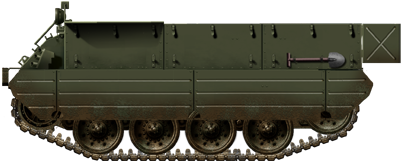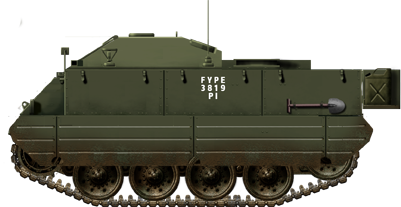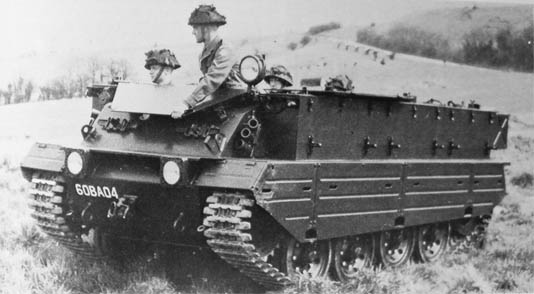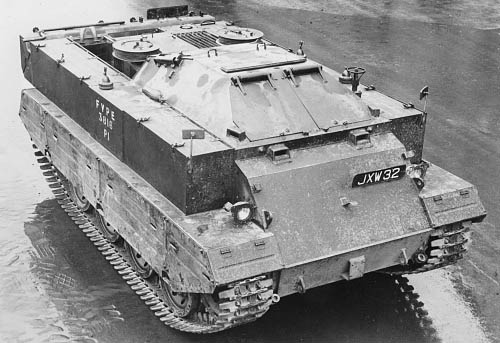The first British enclosed APC
The Cambridge Carrier (FV401) was of box-like construction, fitted with independent torsion bar suspension protected by armoured skirting. A rear engine Rolls-Royce B80 was located at the rear and the front crew compartment was fitted with four hinged armoured flaps, raised for extra protection from shrapnel. The driver was provided with an episcope and the sides buffered by stowage panniers. It was also given a collapsible flotation screen like the Sherman DDs of D-Day and tested with them. Only a few pilot models were built, abundantly troop tested but never entered production.Design
Basically an enhanced oxford carrier, with a modern suspension, produced in small numbers as prototypes. It paved the way for developments which will lead to the FV430 vehicles family, including the FV432 APC, its direct successor. The Cambridge carrier was propelled by a Rolls Royce B80 coupled to a Merrit Brown C5 tranmission (or alternative), mated on the front drive sprockets, while the engine was at the back, in typical British fashion. The brand new suspension (nothing to do with the 1930s Hortsmann system) comprised a set of four roadwheels per side on torsion bars (among the first British vehicles to have those), with roadwheels as idlers at the back and two return rollers. What made it so special was an armoured cab at the front, protected the troops to seat in a fully protected environment. The armoured sides were hinged and could be folded down. The vehicle also had like the Oxford carrier, the added protection offered by the side stowage areas, enclosed in armoured shutters. The limited space available between the transmission and engine made it suitable mostly as an artillery tractor, with just enough space to carry the gun crew and their equipments. Two versions were produced and tested, the FV401 open top vehicle APC/Towing vehicle, and the FV402 Armoured Observation Post, which had a permanently enclosed cabin. But in the end, neither reached serial production.Powerplant & performances
Rolls Royce B80 Mk.2F: 8 cylinder air-cooled inline gasoline engine, coupled with a Merrit-Brown C5 tranmission (five speeds with Wilson pre-selector), same used in the Saracen wheeled APC.Estimated speed around 60 kph on road, 30-40 kph off-road. Range and consumption unknown. The FV402 seemed to have received instead a TN20 Hobbs transmission. "power was transmitted through the transmission unit propeller shaft, Cletrac steering unit and coupling shafts to the final drive assemblies. Either of two types of transmission unit may be fitted, namely the Wilson pre-selective gearbox and the Hobbs transmission unit. Both units simplify gear changing and eliminate the need for a clutch, therefore no clutch pedal is fitted. Vehicles fitted with a Wilson gearbox are however fitted with a gear change pedal. Therefore vehicles fitted with a Hobbs transmission unit can be readily identified by the absence of the gear change pedal, there being only two foot control pedals fitted, the accelerator and the brake" (Nigel Watson, 'Universal Carriers Volume II' page 235). Top speed was about 45 mph, or 72 kph on flat.
Protection

FV402 showing its welded roof, and open armoured shutters and hatches.
The vehicle was protected by light armor all around, with 8 mm glacis plate for the nose, flat sides able to defeat small arms fire and shrapnel. The folded armored cabin assured a better protection than the previous Oxford carrier/Universal Carrier, but the FV402 had actually a fully enclose welded armoured cabin roof, with armoured shutters and hatches. It was also distinguished by its two aerial antennae at the front of the cabin. None were NBC protected. For active protection, they had two banks of three smoke projectors mounted on either side of the glacis plate, as well as fixations for spare track links. The vehicles also mounted metallic side skirts, similar to those used by the Vickers Medium Tank of that time.
Armament
None, but towed artillery, mortar, and crew's personal weapons. One FV432 pilot ended as a target, and was later modified to launched the Malkara missile. It was restored and ended in the collection of Bovington (not accessible to public).Oxford Carrier specifications | |
| Dimensions | Unknown |
| Total weight, battle ready | 11 long tons () |
| Crew | Driver, vehicle + 4-6 gun servants/troops |
| Propulsion | Engine Rolls Royce Inline 8 cyl. petrol B80 Mk2, 100 bhp? |
| Suspension | Torsion bars |
| Speed (road) | 45 mph (72 km/h) |
| Range | Unknown |
| Armament | None |
| Armor | 8 mm (0.3 in) |
| Total production | Circa 6 Prototypes, pilots in 1952-1955. |
Production
About a dozen vehicles (FV401 and 402) were built in small series for tests, so production never ramped up. There was no official order and field tests revealed despite its excllent mobility procured by the new suspension, the vehicle was way too cramped to be an effective infantry carrier. They asked to stretch the driverain by adding an extra pair of roadwheels, which led to the FV420. Focus shifted on the larger platform with same mechanical elements that was the FV420/421, leading in turn to the universal FV430 family, and the FV432 APC. The only two surviving vehicles are at Bovington and and another, for some time at the swords and plowshares collection. All in all, the Cambridge carrier is a foggy vehicle.Read more/Src
On mapleleafup.netFV vehicles listing
The shadock: Surviving_Modified_Foreign_Vehicles (pdf)
British armor 1950-60s
FV432 manual (pdf)
Massimo Foti photos
Vitaly Kuzmin photos
"Making tracks, British Carrier Story 1914 to 1972" by Chamberlain and Ellis
Hogg, Ian V.; Weeks, John (1980). The illustrated encyclopedia of military vehicles. London: New Burlington Books. pp. 199–200.
Hogg, Ian V., and John S. Weeks. (1980). The illustrated encyclopedia of military vehicles. Englewood Cliffs
Suttie, William. (2015). The Tank Factory British Military Vehicle Development and the Chobham Establishment. New York, The History Press.
Chamberlain, Peter, and Chris Ellis. (1973). Making tracks; British carrier story, 1914 to 1972. Windsor: Profile Publications.
Gallery of models

FV401 Cambridge artillery tractor/APC

FV402 Mobile Observation post
Videos (Bovington Museum)
Photo Gallery

FV401 open top Cambridge APC, with the cabin panels folded down (src http://www.mapleleafup.net)

FV402

Cold War Tanks


































Cold war tanks posters

Cold War Main Battle Tanks

Cold War Soviet Army

